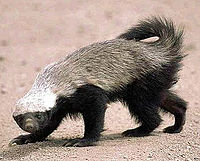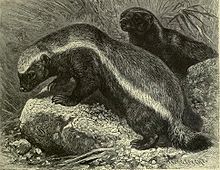蜜 獾
 | ||||||||||||||||
| ||||||||||||||||
| Mellivora capensis (Schreber, 1776) |
解剖 學
[

行為
[
2002
捕食
[繁殖
[
Once a female honey badger comes into heat, courtship is very energetic. After days of deliberation, a male is accepted as a mating partner, and the honey badgers will remain in a burrow for 3-4 days of mating. The female badger will give birth to a cub 2 months later. A honey badger cub is almost a complete replica of its mother, and as it grows, it learns to be aggressive to any other creature (e.g., curious jackals) as it travels across the desert. It relies on its mother for food and shelter as they regularly move and she digs new burrows. Cubs can handicap a honey badger's hunting; therefore, they are usually left back at the den, where they can be vulnerable. It has been documented that other honey badgers will drag cubs from their dens and eat them. Due in part to cannibalistic threats such as this, only half of honey badger cubs will live to adulthood.
As the cub grows up, its ability to navigate the tough terrain of the desert improves by learning from its mother to not only walk, but to also climb trees and to chase snakes. The honey badger is not born with these vital skills for survival, they must be learned.
Once a mother comes back into heat and is ready to rear another cub, the other cub is old enough and skilled enough to survive alone, so it makes its own way in the world, leaving its mother behind. This happens a few months after the cub has been born.
保護
[Regardless of its fierce temperament, the honey badger's low birth rate makes it extremely vulnerable to hunting and habitat destruction. They are often scorned and hunted by farmers who own commercial beehives and believe this animal to be a threat to their livelihoods. Many honey badgers are killed by farmers or stung to death by bees after becoming snared in a hive trap. [4]
Urban legend
[The Killer badger is a creature found in a number of modern urban myths from Basra (Al Basrah) province, Iraq, where it was said to have attacked both people and livestock. It has since been identified as the honey badger, inflated by rumor. [5][6][7][8]
引用
[- ↑ Begg, K., Begg, C. & Abramov, A. (2008). Mellivora capensis. In: IUCN 2008. IUCN Red List of Threatened Species. Downloaded on 21 March 2009. Database entry includes a brief justification of why this species is of least concern
- ↑ Most fearless animal on Animal of the Day
- ↑ "More info on the documentary Snake killers: Honey badgers of the Kalahari".
原著 喺2010年 1月 31號 歸 檔. 喺2009年 3月 23號 搵到. - ↑ Piper, Ross (2007), Extraordinary Animals: An Encyclopedia of Curious and Unusual Animals, Greenwood Press.
- ↑ Weaver, Matthew (2007-07-12), "Basra badger rumour mill", The Guardian (2007-07-16)
- ↑ Philp, Catherine (2007-07-12), "Bombs, guns, gangs - now Basra falls prey to the monster badger 互聯
網 檔案館 嘅歸 檔,歸 檔日期 2011年 9月 17號 ,.", The Times (2007-07-16) - ↑ Baker, Graeme (2007-07-13), "British troops blamed for badger plague 互聯
網 檔案館 嘅歸 檔,歸 檔日期 2008年 1月 13號 ,." The Telegraph (2007-07-16) - ↑ BBC News (2007-07-12) "British blamed for Basra badgers", BBC (2007-07-16)
Gallery
[


